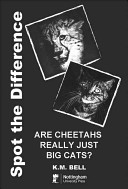Spot the Difference: Are Cheetahs Really Just Big Cats?

Establishing areas in which the domestic cat is a suitable role model for the cheetah, as well as when it is not, this work highlights where the cheetah is unique from the other cats and species-specific in its needs. Highlighting areas such as the ecological, anatomical, and physiological considerations, information is provided on nutrient requirement, metabolism, and reproduction comparisons to the domestic cat. The study is intended to be a useful text for zoo veterinarians, nutritionists, managers, and keepers alike, as well as being of interest to companion animal nutritionists and reproductive physiologists.
Autor: Katherine M. Bell
| Nakladatel | Plot |
|---|---|
| ISBN | 9781904761600 |
| Vydání | 2010 |
| Vazba | brožovaná |
| Počet stran | 139 |
The cheetah is an endangered species, threatened with extinction due to loss of habitat and conflict with humans for land use and prey animals. Although international efforts to save the cheetah include co-ordinated multi-national breeding programmes, the captive cheetah population is not yet self-sustaining. Understanding of cheetah biology has increased dramatically in recent decades but the domestic cat is still commonly used as a model species for the cheetah in captivity when it comes to nutrition and reproduction.
However, is it really fair to extrapolate the nutritional requirements or reproductive anomolies of the domestic cat to its distant relative the cheetah? This book reviews the known differences and similarities in cheetah and cat biology, with particular reference to their nutritional and reproductive physiology. Where examples from either species are missing, comparison is made with other members of the Felidae in order to estimate the likelihood of interspecific differences between the cheetah and cat.
The comparisons made here have particular relevance for the fomulation of diets for captive cheetahs and the development of zoo-based breeding programmes. Furthermore, this book provides zoo managers, breeding co-ordinators, veterinarians and nutritionists with a valuable tool when attempting to identify and correct nutritional inadequacies or reproductive dysfunction in the cheetah.
| Introduction | 1 |
| Phylogenetics | 5 |
| Ecological Comparisons | 11 |
| Prey size | 12 |
| Prey diversity | 16 |
| Feed intake & frequency | 18 |
| Anatomical & Physiological Comparisons | 23 |
| Limbs & claws | 25 |
| The hyoid | 27 |
| The eyes | 27 |
| The skull & brain | 27 |
| Dentition | 30 |
| Heart & lungs | 30 |
| Thermoregulation & muscular adaptations | 31 |
| Liver, kidneys & spleen | 13 |
| Blood chemistry | 32 |
| The digesive systém | 35 |
| Microflora of intestinal tract | 36 |
| Reproductive comparisons | 41 |
| Anatomy of reproducive tract | 43 |
| Life history characteristics | 44 |
| Fertility & fecundity | 45 |
| The female reproductive cycle | 47 |
| Steroid hormone changes of oestrus cycle | 48 |
| Vaginal cytology | 51 |
| Ovulation induction | 54 |
| Seasonality | 55 |
| Puberty onset & sexual maturity | 56 |
| Microflora of reproductive tract | 57 |
| Oestrus behaviour | 57 |
| Gestation & pregnancy detection | 58 |
| Litter size & survival | 59 |
| Birth weight | 60 |
| Maternal milk composition | 60 |
| Interbirth intervals | 62 |
| Neonatal growth | 63 |
| Nutrient requirements, utilisation & metabolism | 65 |
| Nutrient digestibility | 69 |
| Nutrient requirements & deficiencies | 73 |
| Energy | 74 |
| Protein | 75 |
| Amino acids | 77 |
| Sulphur amino acids | 78 |
| Fats, lipids & fatty acids | 79 |
| Carbohydrate | 81 |
| Fibre | 83 |
| Vitamins | 84 |
| Minerals | 87 |
| Secondary plant compounds | 89 |
| Conclusions and practical implications | 93 |
| Practical implications | 100 |
| Bibliography | 105 |
| Index | 125 |